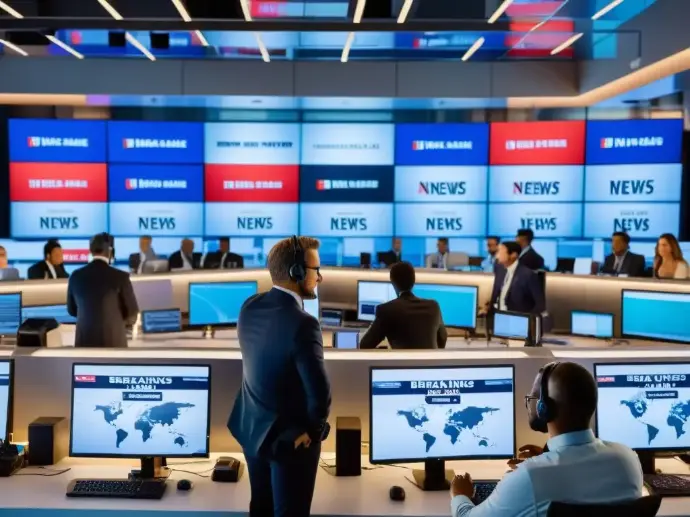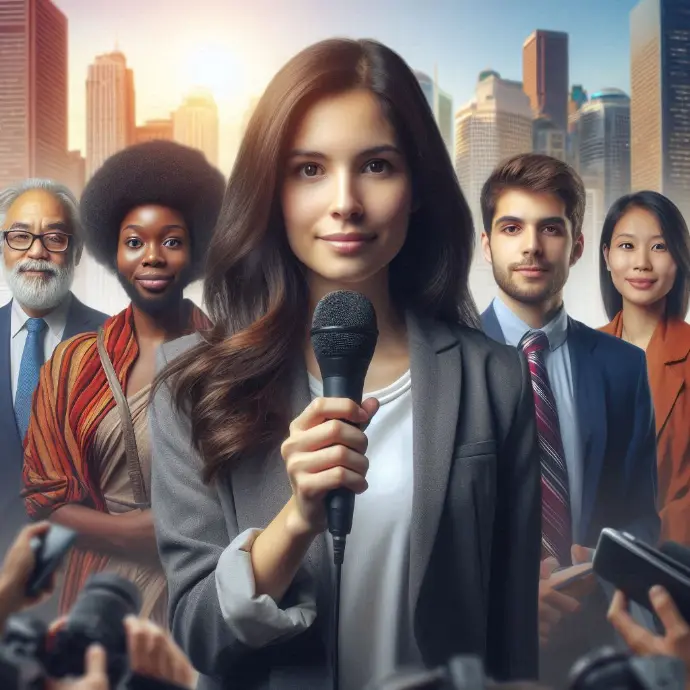
Journalism Without Barriers: The Fight for Accessibility of Information
In this portal, you'll immerse yourself in a comprehensive analysis of the fight for global information accessibility. Our theme, "Journalism Without Barriers: The Fight for Information Accessibility," invites you to discover how freedom of expression is intertwined with the mission of ensuring fair access to information worldwide. Get ready for a journey that raises awareness and promotes reflection!
Back to pageIntroduction
Global information accessibility is an essential element in ensuring that all people, regardless of their geographic location, ethnic origin, physical ability, or socioeconomic status, have the opportunity to access relevant information. In the context of human rights, global information accessibility becomes a fundamental pillar for promoting equality, justice, and citizen participation in matters of public importance.
The availability of relevant and up-to-date information is crucial for empowering communities and enabling them to make informed decisions on issues that affect their lives. Furthermore, global information accessibility plays a fundamental role in holding governments and institutions accountable, as it facilitates the monitoring and evaluation of their actions regarding human rights and other matters of public interest.
In an increasingly interconnected world, global information accessibility has become an ethical and moral imperative, promoting solidarity, mutual understanding, and cooperation among diverse countries, regions, and communities.
The fight for global information accessibility is rooted in the evolution of media and technology. Throughout history, various social movements, human rights advocates, and international organizations have advocated for equitable access to information worldwide.
The Universal Declaration of Human Rights, adopted by the United Nations General Assembly in 1948, recognizes the right of everyone to "seek, receive, and impart information and ideas of all kinds." This landmark document laid the foundation for the promotion of global information accessibility as a fundamental human right.
In recent decades, with the advent of the internet and social media, the fight for global information accessibility has taken on a new dimension, as unprecedented opportunities for sharing and accessing information globally have emerged. However, there has also been a need to address challenges related to the veracity, privacy, and diversity of information available online.
Today, significant progress has been made in promoting global information accessibility. The adoption of access to information laws and policies in several countries, as well as the development of accessible technologies, has contributed to expanding the reach of information available to people around the world.
However, significant challenges remain in the fight for global information accessibility. The digital divide, censorship, misinformation, and information manipulation represent significant obstacles to ensuring that all people have equitable access to relevant and truthful information. Furthermore, the protection of online privacy and security remains a key concern in the context of global information accessibility.
Addressing these challenges requires a comprehensive approach involving governments, technology companies, civil society organizations, and the international community as a whole. Promoting global information accessibility is an ongoing commitment that demands collaboration and collective action to ensure that information is a public good accessible to all.
The Importance of Barrier-Free Journalism
Journalism plays a fundamental role in promoting global information accessibility by acting as a bridge between information and the public. Journalists have a responsibility to investigate, collect, and disseminate relevant, truthful, and timely information, which contributes to empowering communities by providing them with knowledge that allows them to make informed decisions. Furthermore, ethical and quality journalism can act as a counterweight to misinformation and manipulation, promoting transparency and accountability at all levels of society.
Promoting global information accessibility involves not only ensuring that information is available but also that it is understandable and relevant to everyone, regardless of geographic location, language, physical abilities, or socioeconomic status. Journalists play a crucial role in ensuring that information is presented in an accessible manner, using clear language and avoiding jargon or technical terms that may exclude certain groups of the population.
Effective journalism not only informs, but also advocates for equal access to information, thus contributing to building more informed, inclusive, and participatory societies.
Lack of access to information has a devastating impact on marginalized communities, perpetuating their exclusion and limiting their development opportunities. In an increasingly interconnected world, the inability to access relevant information means these communities face additional challenges in areas such as education, health, employment, and civic participation.
For example, lack of access to information on sustainable agricultural practices can negatively impact rural communities' ability to improve their livelihoods. Similarly, the absence of information on human rights and legislation can leave communities vulnerable to exploitation and injustice.
Journalism that addresses these disparities in access to information can help make the needs of these communities visible, raise awareness of their challenges, and pressure decision-makers to ensure equitable access to information for all sectors of society.
Human rights defenders play a crucial role in the fight for information accessibility by advocating for the removal of barriers that impede equitable access to information. These defenders work tirelessly to ensure that all people, regardless of their status, have the ability to seek, receive, and disseminate information safely and freely.
Part of their work involves lobbying governments and other institutions to remove unfair restrictions on access to information, promote transparency, and ensure that the rights to freedom of expression and the press are respected. Furthermore, human rights defenders work to raise awareness about the importance of information accessibility in all areas of life, from education to civic participation.
Ultimately, the work of human rights defenders in this field contributes to the promotion of more just and inclusive societies, where access to information is a fundamental right guaranteed for all.
Journalists and media outlets face significant challenges today in their fight for global information accessibility. One of the most prominent challenges is censorship and repression by authoritarian governments or totalitarian regimes seeking to control information and limit freedom of expression. This type of censorship can hinder access to truthful and complete information, jeopardizing journalists' ability to report objectively and accurately.
Another crucial challenge is disinformation and the spread of fake news online. With the rise of social media and internet platforms, the spread of misinformation or biased information can undermine the credibility of journalism and hinder access to reliable information. Journalists and media outlets face the challenge of combating disinformation and promoting media literacy so that the public can discern between reliable and misleading sources.
Furthermore, the lack of resources and support for independent and investigative journalism represents another significant challenge. Many journalists face precarious working conditions, a lack of legal protection, and significant safety risks when carrying out their work. Independent media outlets struggle to secure funding and resources to conduct in-depth investigations and quality reporting that address issues related to human rights and global news accessibility.
The role of technology in the fight for news accessibility
Technology has played a fundamental role in the fight for information accessibility globally. As technological innovations have evolved, new opportunities have arisen to improve access to information for all people, including those with disabilities. The implementation of accessible technologies has opened up a range of possibilities to ensure that information is accessible and understandable to all, regardless of their physical or cognitive limitations.
The creation of applications and software designed specifically for people with visual, hearing, or motor disabilities has revolutionized the way these individuals can access information. For example, screen readers, speech recognition systems, and voice navigation tools have significantly expanded the opportunities for people with visual impairments to effectively access digital content.
Furthermore, technology has enabled the creation of alternative information formats, such as digital Braille, which makes it easier for people with visual impairments to read content. These technological innovations have not only improved access to information but have also fostered inclusion and participation in the public sphere for those who previously faced significant barriers to accessing information.
The creation of applications and software designed specifically for people with visual, hearing, or motor disabilities has revolutionized the way these individuals can access information. For example, screen readers, speech recognition systems, and voice navigation tools have significantly expanded the opportunities for people with visual impairments to effectively access digital content.
Furthermore, technology has enabled the creation of alternative information formats, such as digital Braille, which makes it easier for people with visual impairments to read content. These technological innovations have not only improved access to information but have also fostered inclusion and participation in the public sphere for those who previously faced significant barriers to accessing information.
Despite advances in accessible technologies, significant challenges remain in the implementation of these solutions globally. One of the main challenges lies in the availability and accessibility of these technologies in countries and communities with limited resources. While in some places accessible technology is widely available, in others, its adoption is limited due to economic, cultural, or infrastructure barriers.
Furthermore, the lack of standardization in the development of accessible technologies can hinder their global implementation. The diversity of technological platforms and operating systems can make it difficult to create solutions that are compatible in all environments, which in turn limits the reach of these technologies.
Another important challenge is the need to raise awareness and train communication and information professionals on the importance of adopting inclusive practices. Often, a lack of knowledge about how to create accessible content can limit the impact of technologies designed to improve news accessibility.
Technology has transformed journalistic practice, opening up new opportunities for the creation and dissemination of accessible news content. Journalists and media outlets have used technological tools to include video subtitles, image descriptions for people with visual impairments, and adapted news presentation formats to different needs. These practices have contributed to greater inclusion of diverse audiences, promoting equal access to information.
Furthermore, technology has enabled the creation of communication and content dissemination platforms that are accessible to people with various disabilities. Live streaming with sign language interpretation, the availability of podcasts with accurate transcripts, and the adaptation of formats for screen readers are concrete examples of the positive impact of technology on inclusive journalism.
Technology has been a key driver in the fight for information accessibility globally, providing innovative tools and solutions to overcome barriers and ensure that everyone has the opportunity to access information equitably.
The fight for global information accessibility has been strengthened through collaborations and strategic alliances between organizations, governments, and technology companies. These partnerships seek to promote the development and implementation of accessible technologies that allow all people, including those with disabilities, to access information equitably. These collaborations seek to develop standards and guidelines for technological accessibility, as well as ensure their implementation on digital platforms and electronic devices.
The active participation of governments and international entities, along with civil society organizations and companies in the technology sector, has been essential in promoting initiatives that seek to eliminate barriers to access to information. These alliances have led to the creation of tools and resources that facilitate the accessibility of online content, such as automatic subtitling in videos, screen readers, and the adaptation of interfaces for people with visual or motor disabilities.
In addition, these collaborations and alliances have contributed to raising awareness and training on the importance of technological accessibility, promoting good practices among developers, designers, and creators of digital content. The collaborative work of various stakeholders has enabled progress toward a more inclusive digital environment, where all people can exercise their right to access and share information equitably and without barriers.
The path to global information accessibility
In the context of the fight for global information accessibility, it is essential to understand the relevant international legislation and policies that have emerged to promote and protect human rights related to access to information. The Universal Declaration of Human Rights, adopted by the United Nations General Assembly in 1948, establishes in Article 19 the right to freedom of opinion and expression, including the right to seek, receive, and impart information and ideas of all kinds without regard for frontiers, either orally, in writing, or in print, in the form of art, or through any other medium of one's choice. This declaration lays the foundation for the protection of information accessibility globally, serving as a fundamental reference in the work of human rights defenders and journalists worldwide.
In addition to the Universal Declaration of Human Rights, there are other legal instruments that support information accessibility at the international level. For example, the Convention on the Rights of Persons with Disabilities, adopted in 2006, recognizes the importance of ensuring that persons with disabilities have access to information on an equal basis with others, including the recognition of sign languages and the promotion of accessible formats for those with visual or hearing impairments. These and other international laws and policies constitute fundamental pillars in the fight for global information accessibility.
It is crucial that countries implement and respect these regulations, and that effective mechanisms exist to ensure their compliance, especially in contexts where freedom of expression and access to information are threatened. The work of human rights defenders and journalists in promoting and defending these international policies is vital to protecting information accessibility worldwide.
Experiences and good practices regarding information accessibility vary widely in different regions of the world, reflecting the unique challenges faced by local communities and the innovative responses emerging to address them. In Europe, for example, media literacy programs have been implemented to empower citizens to critically evaluate the information they access, promoting an understanding of human rights and the importance of diversity of opinions in a democratic society.
In Latin America, various organizations have worked to create digital platforms that compile relevant information on human rights and the situation of vulnerable communities, providing citizens with access to data and analysis that might otherwise be unavailable. These initiatives seek to strengthen transparency and accountability, promoting information accessibility as a fundamental pillar of democracy and the rule of law.
In Africa, citizen journalism projects have been developed to amplify the voices of marginalized communities and promote diversity of perspectives in the media. These initiatives seek to counter unequal access to information by empowering citizens to actively participate in the discussion of issues relevant to their communities.
Education plays a fundamental role in promoting global information accessibility. By providing people with the necessary tools to understand the importance of accessibility and the challenges faced by people with disabilities, a more inclusive environment is fostered. Educational institutions have a responsibility to integrate information accessibility awareness into their curricula, as this will contribute to the development of individuals who are aware of and committed to equal access to information.
Furthermore, awareness-raising plays a crucial role in promoting information accessibility. Through educational campaigns, awareness-raising events, and the dissemination of relevant information, it is possible to increase public understanding of the barriers faced by people with disabilities in their search for information. This awareness-raising can generate momentum for governments, businesses, and other relevant entities to take concrete steps to improve information accessibility in all areas of society.
Education and awareness-raising are essential pillars in promoting information accessibility globally.
By empowering people with knowledge on this topic and raising awareness in society as a whole, the foundation is laid for significant change in the fight for information accessibility.
This awareness-raising and educational work is essential to building a world where everyone has equal opportunities to access information, regardless of their abilities.
The social and cultural impact of information accessibility
Empowering communities through access to information is critical to ensuring equal rights and opportunities worldwide. When people have access to relevant and timely information, they are empowered to make informed decisions that positively impact their lives and their communities. From access to education and healthcare to participation in democratic processes, access to information is a fundamental pillar of individual and collective empowerment.
Furthermore, information accessibility allows marginalized or underrepresented communities to have a voice and visibility in the media and the public sphere. This contributes to the diversity of perspectives and experiences, enriching the information landscape and promoting more equitable representation in all spheres of society.
Access to information is a catalyst for social and cultural change, driving citizen empowerment and participation and fostering a more just and equitable society for all.
Inclusive media plays a crucial role in transforming narratives and representations in the media. By ensuring that the voices and experiences of diverse groups are accessible and visible, entrenched stereotypes are challenged and a more authentic and accurate representation of human diversity is fostered. This not only enriches news content but also promotes empathy, understanding, and mutual respect among different communities and cultures.
Furthermore, inclusive media contributes to building more inclusive societies by challenging prejudices and promoting equal opportunities for all. By exposing the realities of those who have historically been marginalized or ignored in the media, it creates a space for dialogue and reflection that drives positive social change.
Ultimately, inclusive media not only enriches the quality of journalism and the media but also promotes a fairer and more accurate representation of human diversity, fostering understanding and social cohesion.
In conflict and humanitarian crisis contexts, information accessibility faces significant challenges that hinder the effective dissemination of information crucial to the safety and well-being of affected people. Censorship, misinformation, and a lack of communication infrastructure are just some of the obstacles that hamper access to information in these critical situations.
Furthermore, the safety of journalists and communicators working in conflict zones is a constant concern, as they face threats to their physical integrity and freedom of expression. This limits their ability to report independently and accurately on events taking place in these areas, which in turn affects the ability of local communities to be informed and make decisions critical to their safety and well-being.
Information accessibility in conflict and humanitarian crisis contexts is essential to ensuring the protection and well-being of affected populations, but it faces significant challenges that require the continued attention and support of the international community.
Conclusions
In the fight for global information accessibility, significant progress has been made in recent years. Technology has played a crucial role by providing accessibility tools, such as screen readers, voice recognition software, and haptic devices, which have improved access to information for people with visual, hearing, or motor disabilities. Likewise, the adoption of web accessibility standards has made online websites and applications more accessible to all users.
However, challenges remain in this fight. Many websites and digital platforms do not meet accessibility standards, limiting access to information for people with disabilities. Furthermore, in some regions of the world, internet access remains limited, affecting people's ability to access information equitably.
It is essential to continue working to promote information accessibility globally, with the goal of ensuring that all people, regardless of their abilities or geographic location, can fully and effectively exercise their right to access information.
To advance the promotion of inclusive information globally, it is crucial that governments, international organizations, and the private sector collaborate to implement policies and practices that guarantee the accessibility of information. This includes creating legislation requiring accessibility standards for websites and applications, as well as allocating resources to improve internet infrastructure in underdeveloped areas.
Furthermore, it is essential to promote awareness and training in accessible information among journalism, communications, and web design professionals so they can integrate accessibility principles into their daily work. Accessibility education and universal design must become essential components of training in these areas to ensure that information is accessible to all.
Finally, international cooperation and the exchange of good practices in accessible information are essential to drive progress in this area. Establishing partnerships between different actors, collaborating on research, and disseminating success stories can significantly contribute to promoting inclusive information globally.

 IHRO NEWS
IHRO NEWS




